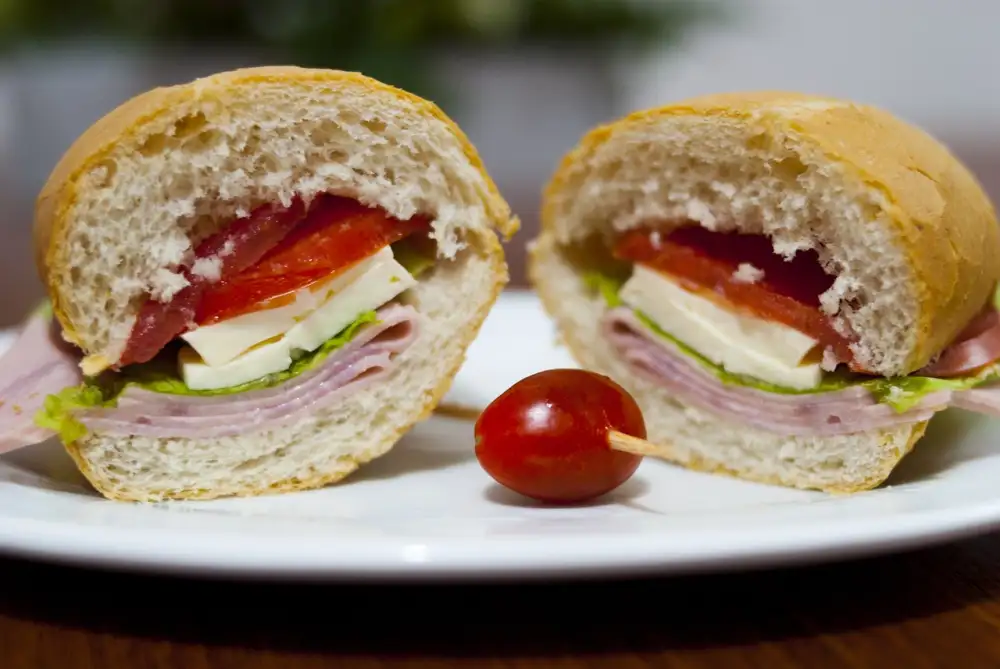The Irresistible Delight of Cuban Bread: Unveiling the Secrets of this Authentic Cuban Cuisine Staple

- History and cultural significance of Cuban bread
- Ingredients used in making Cuban bread
- Traditional baking techniques for Cuban bread
- Unique characteristics and texture of Cuban bread
- Popular dishes and sandwiches made with Cuban bread
- Health benefits of consuming Cuban bread
- Tips for storing and preserving Cuban bread
- Variations and adaptations of Cuban bread in different regions
Cuban bread, a beloved staple of Cuban cuisine, is a delicious and versatile bread that has captured the hearts and taste buds of people around the world. With its crispy crust and soft interior, Cuban bread is known for its irresistible aroma and mouthwatering flavor. Whether enjoyed on its own or used as the foundation for sandwiches and other dishes, this bread holds a special place in the hearts of food enthusiasts everywhere. Join us as we delve into the secrets of Cuban bread and uncover its rich history, unique characteristics, and culinary significance.
History and cultural significance of Cuban bread
Cuban bread holds a rich history and cultural significance in Cuban cuisine. It dates back to the late 1800s when Cuban immigrants introduced their baking traditions to Florida. The bread quickly became an integral part of Cuban-American culture, symbolizing the fusion of Spanish, Caribbean, and African influences. Its popularity soared as it became a staple for traditional dishes like the iconic Cubano sandwich. Today, Cuban bread remains a cherished symbol of Cuban heritage and is enjoyed by people around the world who appreciate its unique flavor and cultural importance.
Ingredients used in making Cuban bread
When it comes to making authentic Cuban bread, the ingredients play a crucial role in achieving its distinct flavor and texture. The traditional recipe calls for only a few simple ingredients, allowing the true essence of the bread to shine through.
The main ingredients used in making Cuban bread include flour, water, yeast, salt, and sometimes a small amount of lard or vegetable shortening. The type of flour used is typically a high-protein bread flour, which gives the bread its characteristic chewiness and structure.
Water is an essential component as it hydrates the dough and activates the yeast. Yeast is responsible for fermentation, which creates carbon dioxide bubbles that give the bread its light and airy texture.
Salt not only enhances the flavor but also helps regulate yeast activity and strengthens gluten development. A small amount of lard or vegetable shortening may be added to enhance the richness and tenderness of the bread.
It's worth noting that Cuban bread does not contain any sugar or eggs, distinguishing it from other types of sweetened or enriched breads. This simplicity allows for versatility in pairing with various dishes without overpowering their flavors.
By using these basic yet carefully selected ingredients in precise proportions, bakers are able to create the perfect foundation for this beloved Cuban staple.
Traditional baking techniques for Cuban bread
Cuban bread is renowned for its unique texture and flavor, which is achieved through traditional baking techniques. The key to making authentic Cuban bread lies in the process of fermentation. The dough is typically made using flour, water, yeast, and a small amount of sugar. Once mixed, the dough is left to rise slowly for several hours. This slow fermentation process allows the flavors to develop and gives the bread its distinct taste.
After the dough has risen, it is shaped into long loaves and scored with diagonal slashes on top. These slashes not only add an aesthetic appeal but also help the bread expand during baking. The loaves are then placed in a hot oven that has been preheated with steam. The steam creates a moist environment, resulting in a crisp crust while keeping the inside soft and airy.
Another important aspect of traditional Cuban bread baking is the use of palmetto leaves or palm fronds during the baking process. These leaves are placed directly on top of the loaves as they bake, adding a subtle smoky flavor to the bread.
The baking time for Cuban bread is relatively short, usually around 20-30 minutes, depending on the size of the loaves. It is essential to remove the bread from the oven when it reaches a golden brown color and sounds hollow when tapped on the bottom.
These traditional baking techniques have been passed down through generations and are still practiced today by Cuban bakers around the world. They play a crucial role in creating that irresistible delight that makes Cuban bread so beloved among food enthusiasts everywhere.
Unique characteristics and texture of Cuban bread
Cuban bread is renowned for its unique characteristics and texture, setting it apart from other types of bread. One of its defining features is the crisp crust that forms during baking. The crust is thin and golden brown, providing a satisfying crunch when bitten into. This contrast between the crunchy exterior and soft interior is what makes Cuban bread so irresistible.
The texture of Cuban bread is light and airy, with a slightly chewy crumb. This is achieved through a combination of factors, including the use of high-protein flour and the fermentation process. The dough undergoes a long fermentation period, allowing the yeast to develop slowly and create small air pockets within the bread. As a result, Cuban bread has a delicate structure that practically melts in your mouth.
Another characteristic of Cuban bread is its subtle sweetness. While not overly sweet like dessert breads, it has a hint of sugar that adds depth to its flavor profile. This touch of sweetness complements savory fillings in sandwiches perfectly, creating a harmonious balance of flavors.
The unique characteristics and texture of Cuban bread make it an ideal choice for various culinary applications. Its lightness allows it to absorb flavors without overpowering them, making it perfect for sandwiches and paninis. The crisp crust holds up well against moist ingredients, ensuring that the sandwich remains intact until the very last bite.
Whether enjoyed on its own or as part of a delicious sandwich creation, Cuban bread's distinctive characteristics and texture are sure to leave you craving more.
Popular dishes and sandwiches made with Cuban bread
Cuban bread is a versatile ingredient that adds a unique flavor and texture to various dishes. One of the most famous uses of Cuban bread is in the iconic Cuban sandwich. This mouthwatering creation consists of layers of roasted pork, ham, Swiss cheese, pickles, and mustard, all pressed between slices of freshly baked Cuban bread. The combination of flavors and the crunchiness of the bread make it an irresistible treat.
Another popular dish that features Cuban bread is the Medianoche sandwich. Similar to the Cuban sandwich, it includes roasted pork, ham, Swiss cheese, pickles, and mustard but is served on a slightly sweeter version of Cuban bread called "Medianoche" bread. This sandwich is traditionally enjoyed late at night or after a night out.
Cuban bread also serves as the perfect base for bruschetta-style appetizers. Slices of toasted Cuban bread are topped with fresh tomatoes, garlic, olive oil, and herbs to create a delicious and refreshing starter.
In addition to these classics, there are endless possibilities for creating unique sandwiches using Cuban bread. From turkey club sandwiches to vegetarian options filled with grilled vegetables and hummus, the sturdy yet soft texture of Cuban bread can handle any filling.
The popularity of these dishes showcases the versatility and appeal of Cuban bread in both traditional and modern culinary creations.
Health benefits of consuming Cuban bread
Cuban bread not only tantalizes our taste buds but also offers several health benefits. Made with simple ingredients like flour, water, yeast, and salt, Cuban bread is low in fat and cholesterol. It is a good source of carbohydrates, providing a quick burst of energy. The fiber content in the bread aids digestion and promotes a healthy digestive system. Additionally, Cuban bread contains essential minerals like iron and calcium that contribute to bone health. So indulge in this delicious treat guilt-free, knowing that you are nourishing your body as well.
Tips for storing and preserving Cuban bread
Tips for Storing and Preserving Cuban Bread
To ensure the freshness and quality of your Cuban bread, here are some useful tips for storing and preserving it:
1. Store in a paper bag: Cuban bread is best stored in a paper bag rather than a plastic one. This allows the bread to breathe, preventing moisture buildup that can lead to mold.
2. Avoid refrigeration: Refrigerating Cuban bread can cause it to become stale quickly. Instead, keep it at room temperature in a cool and dry place.
3. Freeze for long-term storage: If you have excess Cuban bread or want to save it for later, freezing is a great option. Wrap the bread tightly in plastic wrap or aluminum foil before placing it in the freezer.
4. Thaw properly: When ready to enjoy frozen Cuban bread, let it thaw at room temperature for several hours or overnight. Avoid using a microwave or oven to defrost as this can affect its texture.
5. Reheat if desired: To revive leftover Cuban bread or enhance its flavor, you can lightly toast it in an oven or toaster oven. This will give it a crispy crust while keeping the inside soft and fluffy.
By following these simple tips, you can extend the shelf life of your Cuban bread and continue savoring its delicious taste even days after baking.
Variations and adaptations of Cuban bread in different regions
Variations of Cuban bread can be found in different regions, each with its own unique twist. In Miami, for example, the bread is often made with lard instead of vegetable shortening, giving it a richer flavor. In Tampa, the bread is slightly sweeter and softer, making it perfect for sandwiches. In Key West, Cuban bread is often used to make delicious pressed sandwiches called "Cubanitos". These variations showcase the adaptability of Cuban bread and how it has been embraced by different communities while still retaining its authentic taste and texture.
In conclusion, Cuban bread holds a special place in culinary traditions, representing the rich heritage of Cuba. Its unique flavor, crispy crust, and soft interior make it an irresistible delight for bread lovers around the world. From its humble beginnings to becoming a staple in Cuban cuisine, this bread has stood the test of time.
The cultural significance of Cuban bread cannot be overstated. It is not just a food item but a symbol of community and togetherness. Whether enjoyed on its own or used as a base for mouthwatering sandwiches like the Cubano, Cuban bread brings people together and creates lasting memories.
As we celebrate the history and cultural significance of Cuban bread, let us also appreciate the skill and craftsmanship involved in its creation. The traditional baking techniques passed down through generations ensure that each loaf is made with love and care.
While enjoying the delicious taste of Cuban bread, it's important to note its health benefits. Made with simple ingredients and no preservatives, this bread provides essential nutrients like carbohydrates and fiber. It can be part of a balanced diet when consumed in moderation.
To fully savor the flavors of Cuban bread, it's crucial to store and preserve it properly. Keep it in a paper bag or cloth to maintain its texture and prevent it from becoming stale too quickly. If you have leftovers, consider using them for delectable French toast or breadcrumbs.
Although Cuban bread has its roots in Cuba, variations and adaptations can be found in different regions. Each area adds its own twist while still honoring the essence of this beloved bread. Exploring these regional variations allows us to appreciate the diversity within Cuban cuisine.
In conclusion, let us continue to celebrate the rich heritage of Cuban bread by incorporating it into our culinary traditions. Whether enjoying it at home or seeking out authentic Cuban restaurants, let this iconic bread transport you to the vibrant streets of Havana or Miami's Little Havana. Embrace the irresistible delight that is Cuban bread and savor its place in the tapestry of global cuisine.
Published: 23. 11. 2023
Category: Food



